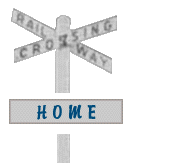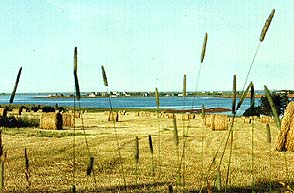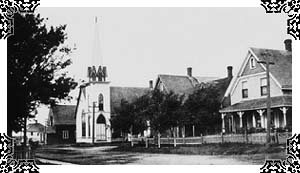









 Methodism
was introduced to the Island in 1774 by Benjamin Chappel.
A native of England, Chappel arrived in New London
Harbour on a ship with over two hundred other immigrants
to the new colony. In actual fact, it was Chappel who
renamed the harbour New London, as he and his countrymen
had great difficulty pronouncing the Mi'Kmaq name for the
bay, which meant "A large body of water surrounded
by land." He also named the area surrounding the
harbour Elizabethtown, after his beloved wife.
Methodism
was introduced to the Island in 1774 by Benjamin Chappel.
A native of England, Chappel arrived in New London
Harbour on a ship with over two hundred other immigrants
to the new colony. In actual fact, it was Chappel who
renamed the harbour New London, as he and his countrymen
had great difficulty pronouncing the Mi'Kmaq name for the
bay, which meant "A large body of water surrounded
by land." He also named the area surrounding the
harbour Elizabethtown, after his beloved wife.
While he may have named the harbour after the bustling city of London, there was next to no resemblance between the two. During the four years he lived in New London, he did even have so much as a church. In the summer, he preached the word from a rock on the bank of the New London river-- a rock known thereafter as Chappel's Pulpit-- and in the winter, he moved indoors to people's homes and the local counting house. If Chappel was not known for starting Methodism on the Island, he would have been just as renowned for becoming the first postmaster on P.E.I. in 1778. He delivered the word, in more than one sense. After Chappel moved to Charlottetown, he opened his home on Sundays and continued to preach to small Methodist congregations.
 Prior to 1889,
Methodist services were held in a local hall in
Kensington. However, when the railway arrived, the
Methodist congregation grew along with the town
population, and by 1887, it was apparent that a new
church was needed. The property for the church was
donated by George W. W. Bentley, a farmer who had moved
to Kensington and set himself up in the mercantile
business. Bentley also served as a member of the
provincial legislature for 15 years, and acted as
Commissioner of Public Lands. In any event, the Methodist
church was certainly grateful for his assistance in their
search for land.
Prior to 1889,
Methodist services were held in a local hall in
Kensington. However, when the railway arrived, the
Methodist congregation grew along with the town
population, and by 1887, it was apparent that a new
church was needed. The property for the church was
donated by George W. W. Bentley, a farmer who had moved
to Kensington and set himself up in the mercantile
business. Bentley also served as a member of the
provincial legislature for 15 years, and acted as
Commissioner of Public Lands. In any event, the Methodist
church was certainly grateful for his assistance in their
search for land.
In 1925, the Church Union of Methodists, Presbyterians, and Congregationalists banded together to form the United Church of Canada. While four of the five Presbyterian session members from Kensington were in favor of union, the issue split the parishioners down the middle. The Presbyterian clergyman-- Rev. A. W. Robertson-- let it be known that he would continue to minister to those who stayed together as anti-Unionists. This part of the Presbyterian congregation soon started holding their own prayer meetings in the King George Hall.
The Unionist Presbyterians, on the other hand,
stood  pat
and continued to worship in the old Presbyterian church.
They celebrated services with visiting ministers until
the Rev. J. P. Saint was called from Bermuda and remained
for several months in 1926. Shortly after April of 1927,
the Presbyterian Unionists decided to unify with the
Methodists, joining them in their place of worship to
form the Kensington United Church.
pat
and continued to worship in the old Presbyterian church.
They celebrated services with visiting ministers until
the Rev. J. P. Saint was called from Bermuda and remained
for several months in 1926. Shortly after April of 1927,
the Presbyterian Unionists decided to unify with the
Methodists, joining them in their place of worship to
form the Kensington United Church.
In 1928, the fifty-year old church underwent extensive renovations, where it was moved back from the street and attached to a concrete basement. In 1965, the Murray Christian Centre was completed, and this complex added a gymnasium, boardroom, stage, and nine classrooms. This centre is a beehive of activity for church members and town residents alike, as it houses a daycare, Sunday school classes, and even an auditorium for community functions. While the beliefs of the church have not changed substantially, its facilities certainly have come a long way since the days of Chappel's Pulpit on the New London riverbank.
